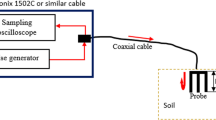Abstract
As we know, soil dielectric property varies along with soil volumetric water content variation. In this paper, the high-frequency resonance measurements method is used to design the soil moisture sensor. Firstly, the high-frequency equivalent electronic model is built by soil and sensor circuit. The relationship between the soil volumetric water content and resonant frequency is established by means of the high-frequency equivalent electronic model analysis. Then, with the comparison test on red soil, moisture soil and paddy soil, the high-frequency resonance measurements method is proved to be effective in soil moisture detection. Finally, the influence of resonant frequency and ambient temperature on the relationship is analyzed. The calibration method of soil moisture sensor is given. The ideally measuring result of soil volumetric water content is obtained. To the best of our knowledge, this paper is the first study on soil moisture sensor design based on soil dielectric property, which covers circuit theory, hardware simulation, resonance frequency selection and temperature compensation. The hardware circuit which is used in soil moisture sensor has advantages of simple structure, efficient practicability. The experiment results show that the soil moisture sensor works well and suits for building large-scale agriculture wireless sensor networks.







Similar content being viewed by others
References
Schieffer J, Dillon C (2013) Precision agriculture and agro-environmental policy. In: Proceedings of the 9th European conference on precision agriculture (ECPA 2013), pp 755–760
Wang X, Hu J et al (2009) Experiment on fast-measurement of soil moisture based on additional resistance method. Trans Chin Soc Agric Eng 25(10):76–81
Celik N, Altin D, Cevik U (2016) A new approach for determination of volumetric water content in soil samples by gamma-ray transmission. Water Air Soil Pollut 227(6):1–9
Zhu A, Zhang (2011) Empirical relationship between soil dielectric constant and volumetric water content in various soils. Acta Pedologica Sinica 48(2):263–268
Ritter A, Regalado CM (2007) Corrections for simultaneous measurements of soil water content and salinity using a capacitance sensor. In: 2007 ASABE Annual International Meeting, Technical Papers, pp 1–10
Rêgo Segundo AK et al (2015) A novel low-cost instrumentation system for measuring the water content and apparent electrical conductivity of soils. Sensors 15(10):25546–25563
Wagner N, Daschner F et al (2014) Estimation of the soil water characteristics from dielectric relaxation spectra. In: 2014 IEEE Sensors Applications Symposium (SAS), pp 242–247
Mizuguchi J, Piai JC et al (2014) Fringing field capacitive sensor for measuring soil MOISTURE content: design, manufacture, and testing. IEEE Trans Instrum Meas 64(1):212–220
Topp GC, Davis JL et al (1980) Electromagnetic determination of soil water content: measurements in coaxial transmission lines. Water Resour Res 16(3):574–582
Herkelrath WN et al (1991) Automatic, real-time monitoring of soil moisture in a remote field area with time domain reflectometry. Water Resour Res 27(5):857–864
Kelleners TJ, Soppe RWO et al (2004) Calibration of capacitance probe sensors using electric circuit theory. Soil Sci Soc Am J 68(2):430–439
Zhao JQ (2005) Dielectric permitivity and its relationship with water content for several soil in China. Master Thesis. Resource and Environment College, Chinese Agricultural University, Beijing
Wang XZ, Liu F, You T (2012) Research of soil profile moisture sensor based on principle of high-frequency capacitance. Transducer Microsyst Technol 31(10):12–15
Xiao MA, Jian MA (2002) The maximum electromagnetic frequency of soil moisture dielectric measurement method. Res Soil Water Conserv 9(2):82–86
Zhang Y, You-Hua MA et al (2014) Development of portable instrument for measurement of soil moisture with temperature compensation. Transducer Microsyst Technol 33(5):73–76
Author information
Authors and Affiliations
Corresponding author
Rights and permissions
About this article
Cite this article
Huan, Z., Wang, H., Li, C. et al. The soil moisture sensor based on soil dielectric property. Pers Ubiquit Comput 21, 67–74 (2017). https://doi.org/10.1007/s00779-016-0975-z
Received:
Accepted:
Published:
Issue Date:
DOI: https://doi.org/10.1007/s00779-016-0975-z




